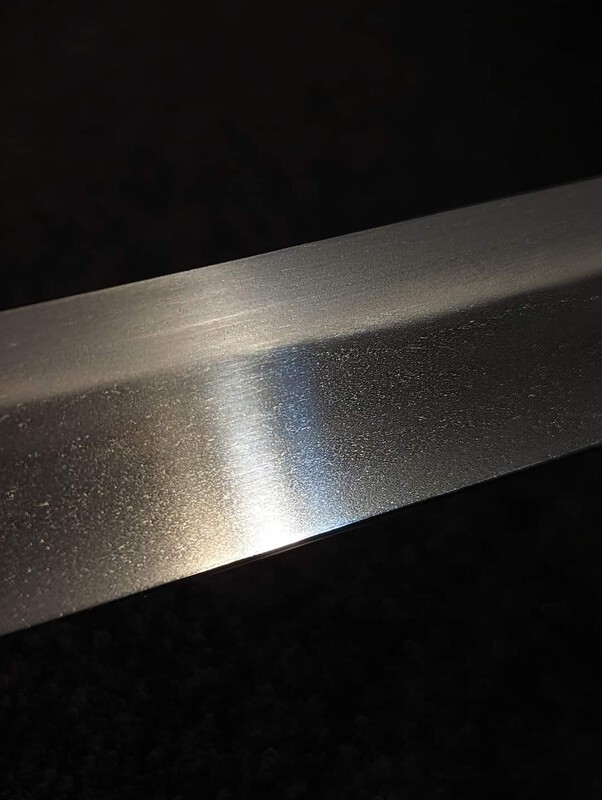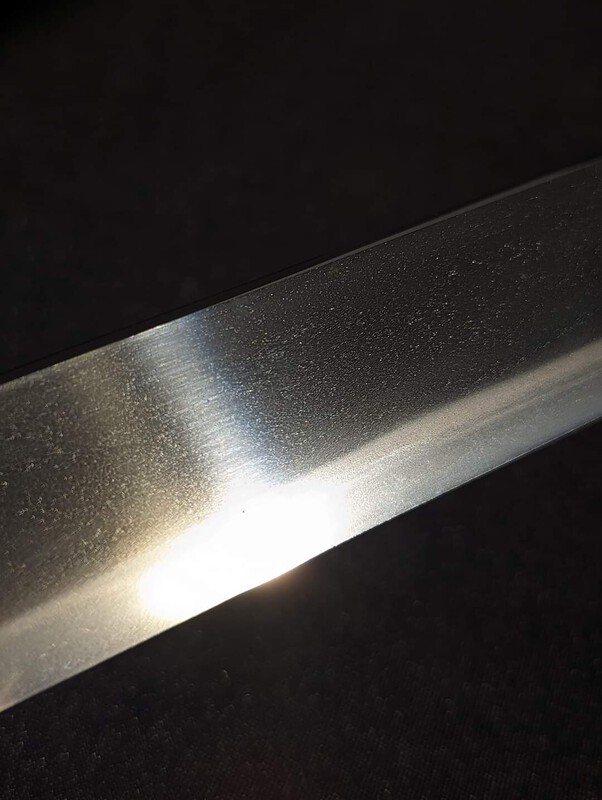-
Posts
4,938 -
Joined
-
Last visited
-
Days Won
132
Content Type
Profiles
Forums
Events
Store
Downloads
Gallery
Everything posted by Ray Singer
-
Omi (no) kami ___ (suriage) I believe the next kanji after Kami is Fuji: https://nihontoclub.com/view/smiths/meisearch?type=All&mei_op=contains&mei=近江守藤
-
Ishihara Kanenao. https://www.google.c...rome-mobile&ie=UTF-8
-
Perhaps 長州住二王清作 Choshu ju Nio Kiyonari
-
I recently had the surprise of seeing that the NBTHK is now awarding Tokubetsu Hozon to osuriage mumei Muromachi blades with only a school attribution, not even to a specific smith, so some of the advice that I've given in the past about how high a mumei Muromachi period blade can achieve needs to evolve.
-
The blade looks like a nice Sue-Bizen tanto with attractive shape. I don't typically recommend investing in restoring mumei Sue-Koto, but I would not completely discount it and it certainly looks too nice to classify only as a tsunagi. Perhaps a madoake is in order, to evaluate the workmanship and health, and decide from there.
-

Shin Gunto Type 98, Family Heirloom restoration project
Ray Singer replied to itsec's topic in Military Swords of Japan
This is one of the most important reasons not to clean or disturb the appearance of the nakago. It is an extremely valuable indicator of age, school, smith, etc. Appearance of the nakago in your sword clearly indicates a blade earlier than the 20th century. -

Custom inscriptions on nakago negatively affects value?
Ray Singer replied to Gerry's topic in Nihonto
You do sometimes see shinsakuto being sold in Japan which have had an inscription column defaced, and it appears evident in these cases that it was a special order column that was removed. I've never heard a western collector object to the presence of a special order inscription on a Japanese sword, especially considering that such an inscription indicates that a sword may exhibit better than average workmanship ( the blade having been made specifically to fulfill a special order request. -

Shin Gunto Type 98, Family Heirloom restoration project
Ray Singer replied to itsec's topic in Military Swords of Japan
Btw, the tall habaki is an interesting feature and not often seen. This is a way to extend the apparent length a blade when a longer blade is needed. -

Shin Gunto Type 98, Family Heirloom restoration project
Ray Singer replied to itsec's topic in Military Swords of Japan
What you have appears to be a shinto blade (from the early Edo period) in shingunto koshirae (army mountings). What I would say immediately is that there's nothing that you should do to remove rust, and whether or not any of the patina on the nakago (tang) has obscured the signature no rust should be disturbed in any way from that area. The nakago, it's patina (color and texture), is a vital characteristic that should be left completely unaltered. -
Bizen no kuni ju Osafune Sukesada Munemitsu saku
-
Signed Tsuda Echizen no kami Sukehiro. Unfortunately the inscription does not appear to be authentic, I would not consider it to be a good target for investing in restoration. Best regards, Ray
-
My impression was earlier.
-
Kaneshige saku * feel better Brian
-

Juyo Ryokai with karasu-guchi
Ray Singer replied to atm's topic in Auctions and Online Sales or Sellers
I am seeing a small and shallow hakobore (chip) and an adjacent scratch, not a crack. -
Unfortunately he is not well documented. The entry from Markus Sesko is just the mei of one particular sword and there is no biographical information.
-
The photo is unclear but I believe it is Genji period (元治). https://en.wikipedia.org/wiki/Genji_era
-
Ashū ju Minamoto Yoshihiro saku
-

Agents for polish , papers etc
Ray Singer replied to Francis Wick's topic in General Nihonto Related Discussion
Ted Tenold - ted@legacyswords.com Robert Hughes - keichodo@yahoo.com -

Curious about a Kanteisho(?) Paper
Ray Singer replied to Marcus Devonport's topic in Translation Assistance
My interpretation would be Sue-koto Kaga (rather than the endpoint of the entire school). I may be incorrect in that reading, but that is my feeling on his intent. -

Curious about a Kanteisho(?) Paper
Ray Singer replied to Marcus Devonport's topic in Translation Assistance
Living National Treasure togishi Fujishiro Matsuo. Attribution: Sue Kashu (late Kaga) -
I believe it is the top of Hiro (寛).
-
薩陽臣奥平元(寛) Satsuyō Shi Oku Taira Moto(hiro)
-
A historically important tanto made in collaboration (gassaku) with Dr. Walter Compton, who did the hamon (performed yaki-ire). Made with the Yasukuni smith Yakuwa Yasutake. For full disclosure, this sword has a hagire (crack) likely due to this sword having been quenched by Compton. Dr. Compton was one of the most important early collectors of Japanese swords in the US and, among many activities, is best known for his return of the National Treasure Kunimune to Japan. YASUTAKE (靖武), Shōwa (昭和, 1926-1989), Tōkyō – “Yakuwa Yasutake saku” (八鍬靖武作), “Tōto ni oite Yakuwa Yasutake kore o saku” (於東都八鍬靖武造作), “Tōto-jū Yasutake” (東都住靖武), real name Yakuwa Takeshi (八鍬武), he was born December 7th 1909 in Sakegawa-mura (鮭川村) in Yamagata Prefecure, in July 1935 he moved to Kyōto to study under Ikeda Yasumitsu (池田靖光), the minister of war granted him the smith name Yasutake in 1944, from that time onwards he also became independent, it is said that after World War II, he did not forge until 1973, i.e. after a break of 28 years, he died in 1984 SOLD
-
I believe it is the same Kato Kunihide identified below: https://nihontoclub....ontains&mei=Kunihide Best regards, Ray
-

Translation and identification help? Thanks
Ray Singer replied to Outpost31's topic in Translation Assistance
Signed Kanetsune and appears to be a Sue-seki (late Muromachi Mino) blade.



























